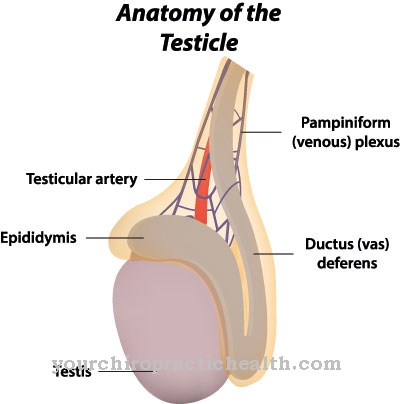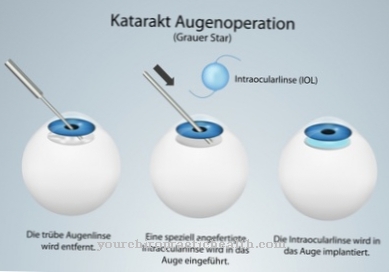Gallbladder polyps are mostly benign tumors, which in many cases are completely symptom-free and are therefore not infrequently discovered only by chance during an ultrasound examination. Smaller polyps usually do not require treatment, but should be checked regularly with ultrasound. For findings larger than ten millimeters, however, the (usually laparoscopic) removal of the entire gallbladder is recommended, since larger gallbladder polyps have a rare risk of degeneration into carcinoma.
What are gallbladder polyps?

© timonina - stock.adobe.com
Gallbladder polyps are among the mostly benign tumors of the gallbladder, which, due to their frequent lack of symptoms, are often discovered only by chance during routine ultrasound examinations.
It is not uncommon for gallbladder polyps to contain cholesterol in addition to mucous membrane cells, which can make them difficult to distinguish from gallstones in sonographic diagnostics. They usually only gain medical relevance from a size of around ten millimeters or a rapid growth trend.
In these cases, due to the risk of the (rare) degeneration of the polyps into carcinoma, the decision will be made to remove the entire gallbladder as a precautionary measure, followed by a histological examination of the tissue. Around one in twenty - men more than women - will experience gallbladder polyps at some point in their life.
causes
One of the main causes of gallbladder polyps - similar to the typical gallstone - is an increased content of cholesterol in the bile. In addition to deposits on the mucous membrane of the gallbladder (cholesteatosis), this also causes cholesterol-containing protrusions of the mucous membrane, the so-called cholesterol polyps.
Interestingly enough, stones and polyps are almost never formed together in the same gallbladder - most patients only ever diagnose one of the two structures. Since in both cases an oversupply of cholesterol leads to the development, an incorrect diet must also be considered as the primary cause.
Other growths in the gallbladder can also promote the formation of polyps. As a rule, they are benign adenomas that develop either from the mucous membrane of the gallbladder or from glandular tissue (cystadenomas) and contribute to the development of gallbladder polyps.
Symptoms, ailments & signs
Gallbladder polyps often remain symptom-free or cause symptoms similar to gallstones. These are benign growths on the gallbladder, but in rare cases they can also become malignant. It has been observed that people who suffer from gallstones do not develop bile polyps.
Conversely, no gallstones form in patients with biliary polyps, regardless of whether they have symptoms or not. Whether symptoms arise with gallbladder polyps depends on the size of the polyps and the stage of development of the disease. Isolated gallbladder polyps often show no symptoms. However, if they occur in connection with other diseases, nausea, vomiting, pain in the right upper abdomen radiating to the shoulder girdle, bloating, flatulence and colic can occur.
These are complaints that can also occur in a similar way with gallstones. With extensive polyp formation, the biliary tract and vascular supply can also be blocked. A blockage of the biliary tract leads to jaundice, which is noticeable by yellowing of the skin and eyes. It also leads to excruciating itching and tiredness.
The liver function can be impaired in such a way that its detoxification function fails. Toxic metabolic products then accumulate in the body. After the affected gallbladder has been removed, the symptoms usually resolve completely. At the same time, it also eliminates the risk of gallbladder polyps turning into gallbladder cancer.
Diagnosis & course
Gallbladder polyps are diagnosed using sonography, although the difference between cholesterol-containing polyps and gallstones is not always clear due to the similar appearance on ultrasound.
It is also possible to overlook the gallbladder polyps - on the one hand, when they are still very small, on the other hand, because they can often not be shown sufficiently delineated from the surrounding tissue structures. Some laboratory values (gamma-GT, alkaline phosphatase) can also reinforce the suspicion that something has happened in the gallbladder.
Often those affected by gallbladder polyps remain completely pain-free, but symptoms such as pain in the right upper abdomen, which can pull into the shoulder, nausea and indigestion are possible, especially in connection with other biliary diseases.
In combination with other disorders (stone, tumor), polyps can cause jaundice through congestion of the bile flow. In the case of larger gallbladder polyps, the - albeit rare - risk of degeneration into carcinoma must also be considered.
Complications
Usually the gallbladder polyps themselves do not cause discomfort, pain or complications. For this reason, the polyps remain undetected for a very long time and in most cases are only diagnosed by chance. However, they can cause pain or nausea in association with other gallbladder diseases.
It is not uncommon for digestive problems or diarrhea to occur. In some cases, jaundice occurs. For this reason, the treatment does not take place in every case. If the gallbladder polyps are relatively small and do not cause discomfort or pain, they are usually not removed.
There are no further complications for the patient and the polyps do not lead to consequential damage. However, if the gallbladder polyps are large and spreading and growing, the entire gallbladder must be removed in most cases. The affected person suffers a relatively strong weight loss and sounds like a general feeling of illness. There is also an increased risk of cancer for the patient. However, there are still no particular complications.
When should you go to the doctor?
Gallbladder polyps often go unnoticed by the patient because they are often symptom-free. They are usually only noticed during a check-up using ultrasound. It is therefore generally advisable to have a check-up carried out by a family doctor at regular intervals. Routine checkups help with early detection and should be used by people of all ages. In addition, a doctor should be consulted as soon as symptoms arise in the vicinity of the abdominal region.
If pain or discomfort occurs repeatedly, it is advisable to have this information clarified by a doctor. If you feel sick, vomit or feel pressure in your chest, you should consult a doctor. If there is a reduced performance, an increased need for sleep or fatigue despite adequate night sleep, these observations should be discussed with a doctor.
If there are changes in digestion, a doctor's visit is necessary as soon as the symptoms persist for several days or increase in intensity. Recurrent diarrhea, constipation, or an intestinal obstruction are cause for concern and should be evaluated medically.
Medical help can also be called upon if the person concerned has a vague feeling of illness or feels inner restlessness. If there is a tightness in the chest or if there are unusual changes in weight, a doctor should be consulted.
Doctors & therapists in your area
Treatment & Therapy
Gallbladder polyps that are small and asymptomatic can be left in the gallbladder without further therapy, provided they are checked regularly by ultrasound.
In the case of rapid growth and generally from an expansion of around ten millimeters, the gallbladder should be completely surgically removed (cholecystectomy). In uncomplicated cases, this is usually done very gently as part of a laparoscopy. For the patient, who does not suffer from major restrictions due to the loss of the gallbladder, neither the operation nor the time after the procedure is usually a difficult burden.
In the case of symptoms such as frequent digestive disorders, chronic fatigue or unwanted weight loss, a degeneration into a precancerous stage or a carcinoma must also be considered, despite the relatively rare occurrence.
If there is a suspicion of advanced disease, surgery can also be performed with the help of an abdominal incision (laparotomy), as this also provides the doctor with a good intraoperative investigation of the abdominal cavity and thus the extent of the disease that has developed on the floor of a gallbladder polyp.
Outlook & forecast
The prognosis for gallbladder polyps depends on the stage of the disease and the size of the polyps present. Basically, a gallbladder polyp is benign and has a good prognosis. The tissue changes can be completely removed in a routine procedure. After the wound has healed, the patient is discharged from the treatment as symptom-free.
The larger the resulting gallbladder polyps, the more likely a malignant course of the disease becomes. This worsens the prognosis for the patient immensely. If left untreated, there is a risk that the symptoms will steadily increase and the general state of health will deteriorate continuously.
There is also a risk of the patient's premature death. Cancer cells develop and can spread in the body to metastasize elsewhere. An early diagnosis and treatment is therefore crucial for the further course of gallbladder polyps.
Although the removal of the tissue changes leads to rapid recovery in normal cases, the patient can be exposed to new polyps at any time. A new outbreak of the disease with the same prognosis is possible in the course of life. If the gallbladder polyps are in hard-to-reach places, there is a possibility of complications during the procedure. Damage to the surrounding tissue can occur, delay healing or impairment.
prevention
No specific form of prophylaxis is known for gallbladder polyps. However, as some polyps contain cholesterol - as is the case with gallstones - a conscious and healthy diet can at least have a positive effect by reducing the cholesterol content in the bile.
There is an important method of prevention in relation to the possible degeneration of gallbladder polyps into carcinomas: If small polyps have already been diagnosed, they should be checked regularly. From a size of about ten millimeters, gallbladder polyps, including the bile, should be removed prophylactically.
You can do that yourself
In everyday life, the patient should take care to lower his cholesterol level permanently through his food intake. For this a change in diet is important. The consumption of animal fats should be reduced or avoided.
On the other hand, foods such as tomatoes, nuts, whole grain products, garlic, onions or leeks are helpful. These should be used more often when preparing meals. The consumption of fruit and vegetables should be increased overall. In addition, foods containing soy or tofu support the health of those affected.
Avoid excessive consumption of coffee when hydrating. Mineral water or green tea help to relieve the discomfort. Products such as butter, cream, meat, eel, smoked fish, rapeseed or olive oil increase the cholesterol level. They are to be removed from the nutrition plan or greatly reduced.
In addition to changing their diet, the patient can take some measures to stimulate the metabolism. Sufficient exercise, regular sporting activities and the avoidance of nicotine or alcohol promote health and support the recovery process.
If symptoms such as nausea or dizziness occur, the patient should take it easy and allow sufficient rest. Avoid overexertion. The needs and possibilities of the organism should be taken into account in all activities so that there is no deterioration in health.

.jpg)

























